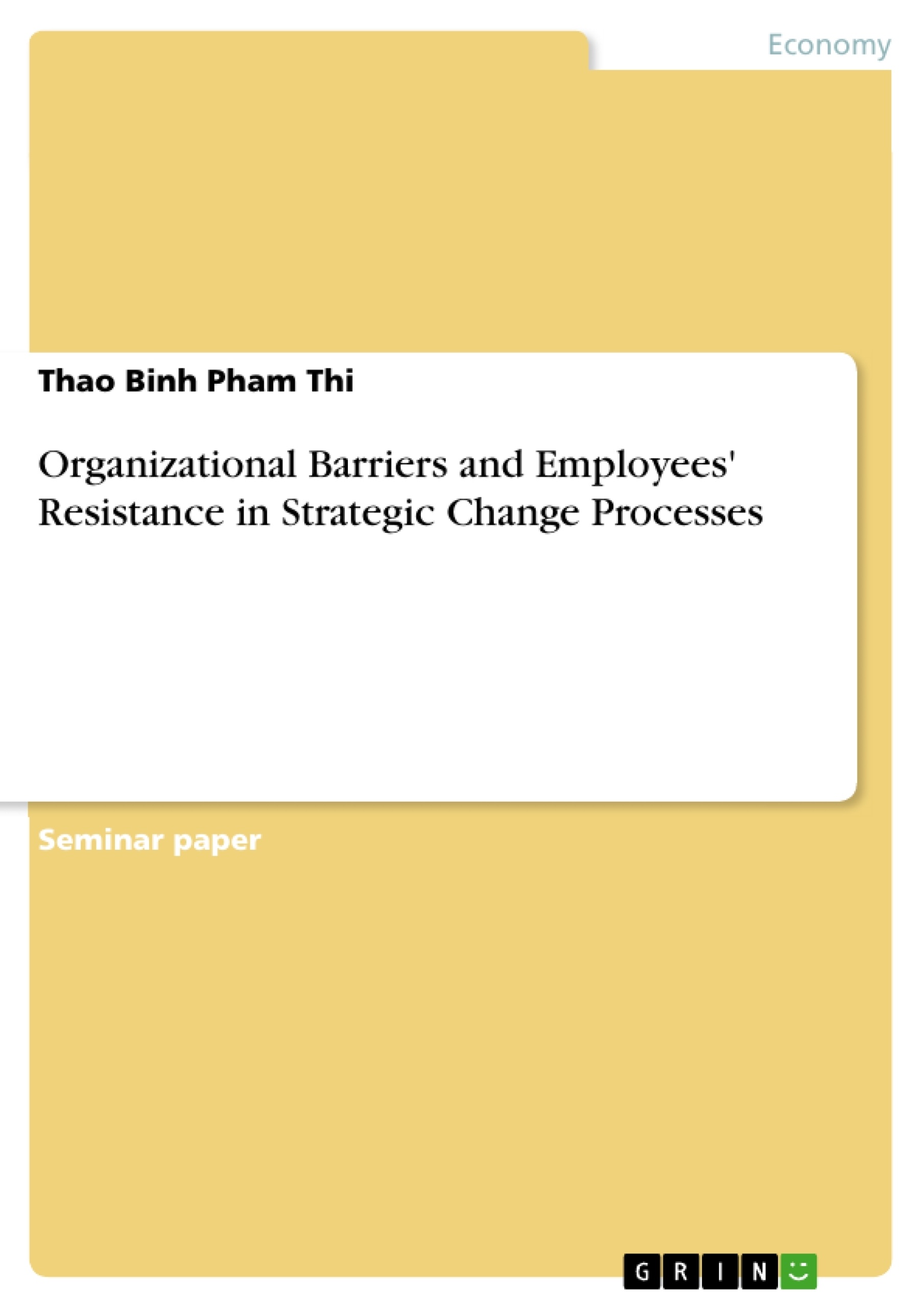The impact of strategic change processes on the organization and its individuals
Dramatic environmental shifts due to the rapid increase of dynamic and complexity have put organizations under high pressure.1 Consequently organizations are forced to undergo strategic changes in order to create organizational adaptability and flexibility to prevail in heavily disputed markets.2 However, although organizational change 3 is considered to be essential the success rate of change is still very low. The reasons for these failures are quite obvious but they are not well acknowledged. However one crucial reason is that employees and organizations, the change targets, do not welcome changes at all.4 Moreover as a natural reaction they will inevitably resist change.5 Considering these difficulties the resistance of organizations and its members to changes should be seen as the central challenge of change management and be taken seriously to improve the change performance of organizations. 6 To meet this challenge it is essential that change agents7 acknowledges as well as understands resistance already at an early stage so that adequate strategies can be developed at the right time. In consequence the management of change should focus on a constructive approach of resistance since it is stated as one of the key success factors of change management.8
The objective of this paper is to give firstly comprehensive reasons why organizational barriers and employees’ resistance towards change exist and secondly reasonable methods that are able to reduce and overcome resistance to change. The paper consists of two crucial parts. The first one is the analysis of resistance consisting of the two elements recognizing the symptoms and understanding the reasons of resistance. The second part deals with ways to handle resistance by applying different kinds of effective methods in order to overcome resistance as well as to create a framework within future changes can be carried out more easily...
---
1 Swanda (1979), p. 497.
2 Reiß (1997a), p. 6.
3 In this paper organizational change is used as the synonym for strategic change.
4 Strebel (1998), pp. 140-141.
5 Robbins (1998), p. 632.
6 Pardo del Val/Fuentes, p. 148.
7 Change agents are those who conduct change directly whereas change managers have the overall responsi- bilities for the change and its success; Connor/Lake (1994), p. 12.
8 Connor/Lake (1994), p. 133.
Table of Contents
- The impact of strategic change processes on the organization and its individuals
- Basics of organizational change, change management and resistance to change
- Archetypes and change patterns of organizational change
- Definition, objectives, process and tasks of change management
- Definition and types of resistance to strategic change
- Identifying and understanding organizational barriers and employees' resistance in strategic change processes.
- The symptoms of resistance to change.
- Reasons for the existence of organizational barriers and the analysis of organizational inertia
- The analysis of cultural barriers
- Reasons for the formation of employees' resistance
- Promoting strategic change: Methods for overcoming organizational barriers and employees' resistance
- Organizational culture as a lever for handling organizational barriers and employees' resistance.
- Methods for reducing organizational barriers in strategic change
- Methods for coping with employees' resistance to strategic change
- The positive perspective of resistance: Regarding resistance as a constructive tool for management
Objectives and Key Themes
This paper aims to provide a comprehensive understanding of the reasons behind organizational barriers and employees' resistance to change. It further explores effective methods to reduce and overcome resistance to change.
- The nature of organizational change and its different archetypes and patterns.
- Identifying and understanding the symptoms and reasons behind resistance to change.
- Exploring strategies and methods for overcoming organizational barriers and employee resistance.
- The role of organizational culture in managing resistance to change.
- The positive perspective of resistance as a constructive tool for management.
Chapter Summaries
- The impact of strategic change processes on the organization and its individuals: This chapter introduces the context of organizational change, emphasizing the need for adaptability in dynamic environments. It highlights the challenges of resistance to change and the importance of understanding and managing it effectively.
- Basics of organizational change, change management and resistance to change: This chapter delves into the different archetypes and patterns of organizational change, including strategy change, resource change, and structure change. It also introduces the concepts of revolutionary and evolutionary change, highlighting the need for effective change management.
- Identifying and understanding organizational barriers and employees' resistance in strategic change processes.: This chapter examines the symptoms of resistance to change, exploring the reasons behind the existence of organizational barriers and the analysis of organizational inertia. It also analyzes the factors contributing to employees' resistance.
- Promoting strategic change: Methods for overcoming organizational barriers and employees' resistance: This chapter focuses on practical methods for handling organizational barriers and employee resistance, emphasizing the role of organizational culture as a lever for change. It explores strategies for reducing organizational barriers and coping with employee resistance.
Keywords
The core keywords and topics explored in this work include organizational change, strategic change, resistance to change, change management, organizational barriers, employee resistance, organizational culture, and constructive approaches to managing resistance.
- Quote paper
- Thao Binh Pham Thi (Author), 2003, Organizational Barriers and Employees' Resistance in Strategic Change Processes, Munich, GRIN Verlag, https://www.grin.com/document/36215



